Paola Cascante-Bonilla
Can Hallucination Correction Improve Video-Language Alignment?
Feb 20, 2025Abstract:Large Vision-Language Models often generate hallucinated content that is not grounded in its visual inputs. While prior work focuses on mitigating hallucinations, we instead explore leveraging hallucination correction as a training objective to improve video-language alignment. We introduce HACA, a self-training framework learning to correct hallucinations in descriptions that do not align with the video content. By identifying and correcting inconsistencies, HACA enhances the model's ability to align video and textual representations for spatio-temporal reasoning. Our experimental results show consistent gains in video-caption binding and text-to-video retrieval tasks, demonstrating that hallucination correction-inspired tasks serve as an effective strategy for improving vision and language alignment.
Natural Language Inference Improves Compositionality in Vision-Language Models
Oct 29, 2024



Abstract:Compositional reasoning in Vision-Language Models (VLMs) remains challenging as these models often struggle to relate objects, attributes, and spatial relationships. Recent methods aim to address these limitations by relying on the semantics of the textual description, using Large Language Models (LLMs) to break them down into subsets of questions and answers. However, these methods primarily operate on the surface level, failing to incorporate deeper lexical understanding while introducing incorrect assumptions generated by the LLM. In response to these issues, we present Caption Expansion with Contradictions and Entailments (CECE), a principled approach that leverages Natural Language Inference (NLI) to generate entailments and contradictions from a given premise. CECE produces lexically diverse sentences while maintaining their core meaning. Through extensive experiments, we show that CECE enhances interpretability and reduces overreliance on biased or superficial features. By balancing CECE along the original premise, we achieve significant improvements over previous methods without requiring additional fine-tuning, producing state-of-the-art results on benchmarks that score agreement with human judgments for image-text alignment, and achieving an increase in performance on Winoground of +19.2% (group score) and +12.9% on EqBen (group score) over the best prior work (finetuned with targeted data).
PropTest: Automatic Property Testing for Improved Visual Programming
Mar 25, 2024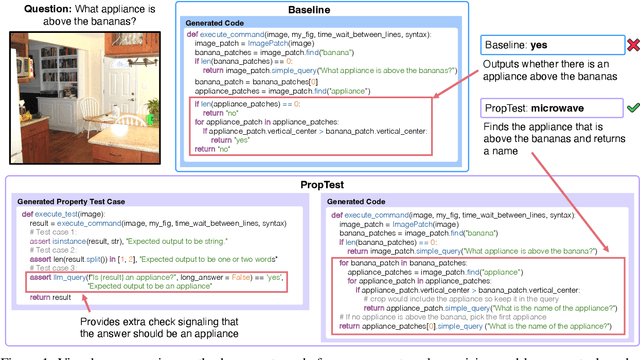
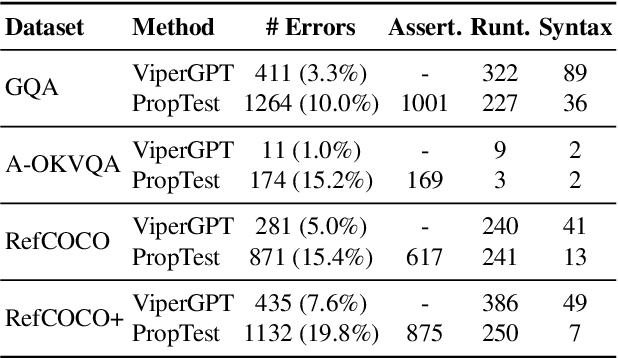

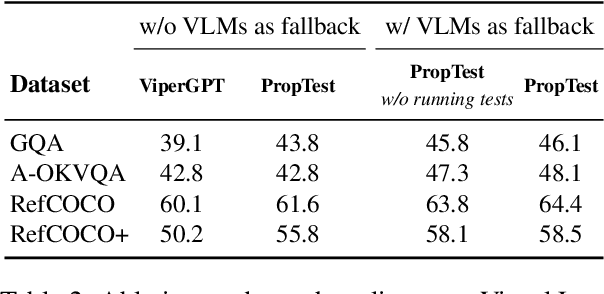
Abstract:Visual Programming has emerged as an alternative to end-to-end black-box visual reasoning models. This type of methods leverage Large Language Models (LLMs) to decompose a problem and generate the source code for an executable computer program. This strategy has the advantage of offering an interpretable reasoning path and does not require finetuning a model with task-specific data. We propose PropTest, a general strategy that improves visual programming by further using an LLM to generate code that tests for visual properties in an initial round of proposed solutions. Particularly, our method tests for data-type consistency, as well as syntactic and semantic properties in the generated solutions. Our proposed solution outperforms baselines and achieves comparable results to state-of-the-art methods while using smaller and publicly available LLMs (CodeLlama-7B and WizardCoder-15B). This is demonstrated across different benchmarks on visual question answering and referring expression comprehension, showing the efficacy of our approach in enhancing the performance and generalization of visual reasoning tasks. Specifically, PropTest improves ViperGPT by obtaining 48.66% accuracy (+8.3%) on the A-OKVQA benchmark and 52.8% (+3.3%) on the RefCOCO+ benchmark using CodeLlama-7B.
Learning from Models and Data for Visual Grounding
Mar 20, 2024



Abstract:We introduce SynGround, a novel framework that combines data-driven learning and knowledge transfer from various large-scale pretrained models to enhance the visual grounding capabilities of a pretrained vision-and-language model. The knowledge transfer from the models initiates the generation of image descriptions through an image description generator. These descriptions serve dual purposes: they act as prompts for synthesizing images through a text-to-image generator, and as queries for synthesizing text, from which phrases are extracted using a large language model. Finally, we leverage an open-vocabulary object detector to generate synthetic bounding boxes for the synthetic images and texts. We finetune a pretrained vision-and-language model on this dataset by optimizing a mask-attention consistency objective that aligns region annotations with gradient-based model explanations. The resulting model improves the grounding capabilities of an off-the-shelf vision-and-language model. Particularly, SynGround improves the pointing game accuracy of ALBEF on the Flickr30k dataset from 79.38% to 87.26%, and on RefCOCO+ Test A from 69.35% to 79.06% and on RefCOCO+ Test B from 53.77% to 63.67%.
Grounding Language Models for Visual Entity Recognition
Feb 28, 2024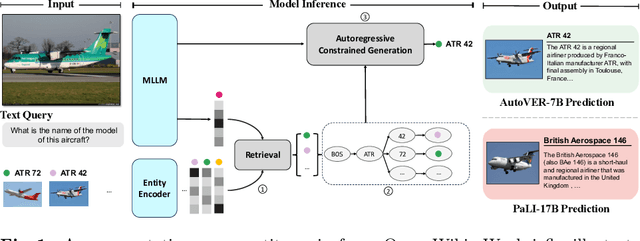
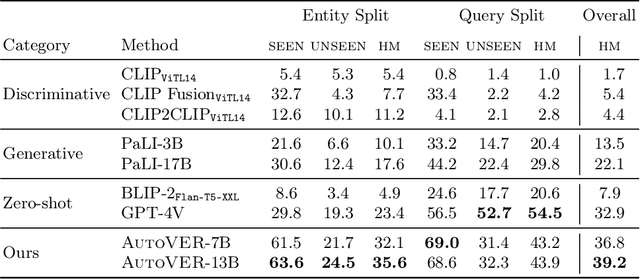
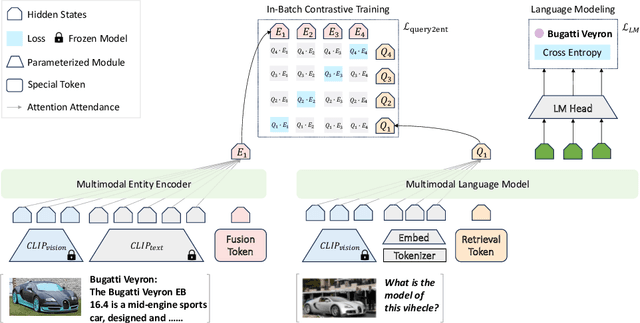
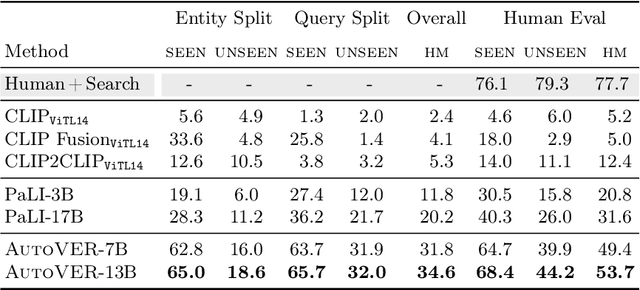
Abstract:We introduce AutoVER, an Autoregressive model for Visual Entity Recognition. Our model extends an autoregressive Multi-modal Large Language Model by employing retrieval augmented constrained generation. It mitigates low performance on out-of-domain entities while excelling in queries that require visually-situated reasoning. Our method learns to distinguish similar entities within a vast label space by contrastively training on hard negative pairs in parallel with a sequence-to-sequence objective without an external retriever. During inference, a list of retrieved candidate answers explicitly guides language generation by removing invalid decoding paths. The proposed method achieves significant improvements across different dataset splits in the recently proposed Oven-Wiki benchmark. Accuracy on the Entity seen split rises from 32.7% to 61.5%. It also demonstrates superior performance on the unseen and query splits by a substantial double-digit margin.
Improved Visual Grounding through Self-Consistent Explanations
Dec 07, 2023Abstract:Vision-and-language models trained to match images with text can be combined with visual explanation methods to point to the locations of specific objects in an image. Our work shows that the localization --"grounding"-- abilities of these models can be further improved by finetuning for self-consistent visual explanations. We propose a strategy for augmenting existing text-image datasets with paraphrases using a large language model, and SelfEQ, a weakly-supervised strategy on visual explanation maps for paraphrases that encourages self-consistency. Specifically, for an input textual phrase, we attempt to generate a paraphrase and finetune the model so that the phrase and paraphrase map to the same region in the image. We posit that this both expands the vocabulary that the model is able to handle, and improves the quality of the object locations highlighted by gradient-based visual explanation methods (e.g. GradCAM). We demonstrate that SelfEQ improves performance on Flickr30k, ReferIt, and RefCOCO+ over a strong baseline method and several prior works. Particularly, comparing to other methods that do not use any type of box annotations, we obtain 84.07% on Flickr30k (an absolute improvement of 4.69%), 67.40% on ReferIt (an absolute improvement of 7.68%), and 75.10%, 55.49% on RefCOCO+ test sets A and B respectively (an absolute improvement of 3.74% on average).
Going Beyond Nouns With Vision & Language Models Using Synthetic Data
Mar 30, 2023



Abstract:Large-scale pre-trained Vision & Language (VL) models have shown remarkable performance in many applications, enabling replacing a fixed set of supported classes with zero-shot open vocabulary reasoning over (almost arbitrary) natural language prompts. However, recent works have uncovered a fundamental weakness of these models. For example, their difficulty to understand Visual Language Concepts (VLC) that go 'beyond nouns' such as the meaning of non-object words (e.g., attributes, actions, relations, states, etc.), or difficulty in performing compositional reasoning such as understanding the significance of the order of the words in a sentence. In this work, we investigate to which extent purely synthetic data could be leveraged to teach these models to overcome such shortcomings without compromising their zero-shot capabilities. We contribute Synthetic Visual Concepts (SyViC) - a million-scale synthetic dataset and data generation codebase allowing to generate additional suitable data to improve VLC understanding and compositional reasoning of VL models. Additionally, we propose a general VL finetuning strategy for effectively leveraging SyViC towards achieving these improvements. Our extensive experiments and ablations on VL-Checklist, Winoground, and ARO benchmarks demonstrate that it is possible to adapt strong pre-trained VL models with synthetic data significantly enhancing their VLC understanding (e.g. by 9.9% on ARO and 4.3% on VL-Checklist) with under 1% drop in their zero-shot accuracy.
CODA-Prompt: COntinual Decomposed Attention-based Prompting for Rehearsal-Free Continual Learning
Nov 23, 2022



Abstract:Computer vision models suffer from a phenomenon known as catastrophic forgetting when learning novel concepts from continuously shifting training data. Typical solutions for this continual learning problem require extensive rehearsal of previously seen data, which increases memory costs and may violate data privacy. Recently, the emergence of large-scale pre-trained vision transformer models has enabled prompting approaches as an alternative to data-rehearsal. These approaches rely on a key-query mechanism to generate prompts and have been found to be highly resistant to catastrophic forgetting in the well-established rehearsal-free continual learning setting. However, the key mechanism of these methods is not trained end-to-end with the task sequence. Our experiments show that this leads to a reduction in their plasticity, hence sacrificing new task accuracy, and inability to benefit from expanded parameter capacity. We instead propose to learn a set of prompt components which are assembled with input-conditioned weights to produce input-conditioned prompts, resulting in a novel attention-based end-to-end key-query scheme. Our experiments show that we outperform the current SOTA method DualPrompt on established benchmarks by as much as 5.4% in average accuracy. We also outperform the state of art by as much as 6.6% accuracy on a continual learning benchmark which contains both class-incremental and domain-incremental task shifts, corresponding to many practical settings.
On the Transferability of Visual Features in Generalized Zero-Shot Learning
Nov 22, 2022Abstract:Generalized Zero-Shot Learning (GZSL) aims to train a classifier that can generalize to unseen classes, using a set of attributes as auxiliary information, and the visual features extracted from a pre-trained convolutional neural network. While recent GZSL methods have explored various techniques to leverage the capacity of these features, there has been an extensive growth of representation learning techniques that remain under-explored. In this work, we investigate the utility of different GZSL methods when using different feature extractors, and examine how these models' pre-training objectives, datasets, and architecture design affect their feature representation ability. Our results indicate that 1) methods using generative components for GZSL provide more advantages when using recent feature extractors; 2) feature extractors pre-trained using self-supervised learning objectives and knowledge distillation provide better feature representations, increasing up to 15% performance when used with recent GZSL techniques; 3) specific feature extractors pre-trained with larger datasets do not necessarily boost the performance of GZSL methods. In addition, we investigate how GZSL methods fare against CLIP, a more recent multi-modal pre-trained model with strong zero-shot performance. We found that GZSL tasks still benefit from generative-based GZSL methods along with CLIP's internet-scale pre-training to achieve state-of-the-art performance in fine-grained datasets. We release a modular framework for analyzing representation learning issues in GZSL here: https://github.com/uvavision/TV-GZSL
ConStruct-VL: Data-Free Continual Structured VL Concepts Learning
Nov 17, 2022



Abstract:Recently, large-scale pre-trained Vision-and-Language (VL) foundation models have demonstrated remarkable capabilities in many zero-shot downstream tasks, achieving competitive results for recognizing objects defined by as little as short text prompts. However, it has also been shown that VL models are still brittle in Structured VL Concept (SVLC) reasoning, such as the ability to recognize object attributes, states, and inter-object relations. This leads to reasoning mistakes, which need to be corrected as they occur by teaching VL models the missing SVLC skills; often this must be done using private data where the issue was found, which naturally leads to a data-free continual (no task-id) VL learning setting. In this work, we introduce the first Continual Data-Free Structured VL Concepts Learning (ConStruct-VL) benchmark and show it is challenging for many existing data-free CL strategies. We, therefore, propose a data-free method comprised of a new approach of Adversarial Pseudo-Replay (APR) which generates adversarial reminders of past tasks from past task models. To use this method efficiently, we also propose a continual parameter-efficient Layered-LoRA (LaLo) neural architecture allowing no-memory-cost access to all past models at train time. We show this approach outperforms all data-free methods by as much as ~7% while even matching some levels of experience-replay (prohibitive for applications where data-privacy must be preserved).
 Add to Chrome
Add to Chrome Add to Firefox
Add to Firefox Add to Edge
Add to Edge